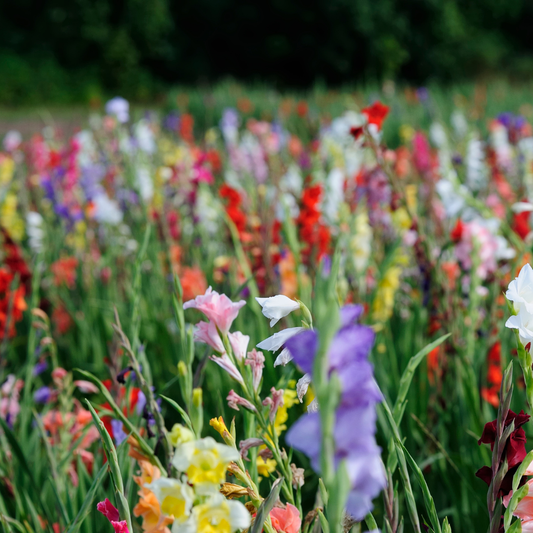
When to plant Autumn Anemone?
Share
When to plant autumn anemone: the right time for this colorful beauty
Why would you want autumn anemones in your garden?
Japanese anemones, also known as autumn anemones, are perennials that steal the show from August to October. Just when many other flowers have given up, these elegantly waving blooms burst into bloom. They're the perfect addition to an autumn border and also attract bees, making them particularly attractive for biodiversity.They come in soft pastel shades like white and pink, but also in more intense lilac or bright flowers. They're low-maintenance, frost-resistant, and thrive in both sun and partial shade, as long as the soil is well-drained. And the best part? They simply return year after year, with ever more flowers.
When is the best time to plant autumn anemones?
The ideal time to plant autumn anemone is early spring—March or April—or early autumn, September, and October. This gives the root system enough time to establish before the winter season or just before the summer heat. In the open ground, it's best to plant them on a day without bright sunlight, and it can be a bit cloudy or drizzly. This way, the soil won't dry out immediately, and the young plants have a better chance to establish themselves without stress.If you're planting in a greenhouse, you can do so a bit earlier—think February to early March—because you'll be less exposed to frost and icy winds. Just make sure there's adequate ventilation and no heat during the day. In a greenhouse, they'll grow faster, especially as cuttings or young plants, so regular watering is important.
For even more inspiration on when planting is a good idea, check out our blog on when to plant anemones .
How do you plant an autumn anemone (in the ground or in a pot)?
Planting in the open ground
Prepare the soil well. Japanese anemones prefer humus-rich, moisture-retaining, but well-drained soil. Dig a planting hole twice as wide as the root ball and mix in some compost or well-rotted manure. Plant the Japanese anemone at approximately the same depth as it was in its original pot. Water thoroughly immediately after planting. Planting on a rainy day also helps maintain moisture levels—an added bonus.In the border they go very well with plants such as Calathea or Asplenium Parvati , if you want to extend the atmosphere of the combination indoors to outdoors.
Plant in pots or containers
Even those with a patio or balcony can enjoy autumn anemones. Choose a sufficiently large pot with drainage holes and use airy potting soil. You'll find suitable potting soil mixes in our potting soil and accessories collection . Add some perlite or pumice to optimize drainage. Do remember to water regularly: pots dry out faster than open ground.Tip: Place your pots in a sheltered spot during cold autumn nights, especially in their first year.
Location and care tips
Japanese anemones prefer partial shade to full sun. Morning sun is especially pleasant, but they don't handle a full day of scorching midday sun very well, unless you ensure sufficient moisture in the soil.During hot, dry summers, regular watering is essential. It's better to give them plenty of water once or twice a week than a little every day. And if you want to give them an extra treat, you can work some worm castings or compost around the root zone in spring for a healthy boost.
Combine with other autumn plants
Autumn anemones make a dream duo with plants like ornamental grasses, asters, and ferns. Looking for some inspiration for easy and low-maintenance houseplants or garden plants? Then the robust ZZ Plant or the Yucca might be just the thing for you. They beautifully complement the anemones' autumn colors—the leaves, in particular, make all the difference.You might also like to check out our Top Picks for outdoor plants in the outdoor plants collection.
Frequently asked questions about the autumn anemone
Can I cut or propagate them?
Absolutely! Japanese anemones form underground root suckers. After a few years, you can dig them up and divide them in the spring. Each piece with a root tip has the potential to grow into a new plant. Be careful, though: they like to spread, so give them some space.Are autumn anemones winter hardy?
Yes, these plants can easily survive in our Belgian climate. Even during a harsh winter, they die back above ground, but bravely emerge from the soil again in spring. Provide a layer of mulch in the winter to give young plants extra protection.Why isn't my autumn anemone blooming?
Is it perhaps in too much shade, or is the soil too dry? Japanese anemones prefer moist, fertile soil. Give them some time, as they're often slow growers in the first year. But once they're well established, they'll bloom naturally and even more profusely in subsequent years.What color varieties are there?
From pure white to dusky pink, there's something for every taste. Popular varieties include Anemone 'Honorine Jobert' (white), 'September Charm' (soft pink), and 'Pamina' (deeper pink). By combining different varieties, you'll enjoy weeks of blooms and vibrant color.Plant your autumn anemone today!
Whether you're a novice plant enthusiast or a seasoned gardener, the autumn anemone is a rewarding plant that largely takes care of itself. Just keep timing, location, and care in mind, and you'll be rewarded with a colorful autumn display.Want to get started with even more plants at the right time? Then be sure to check out our other blogs, such as when to plant asters or easy houseplants for beginners .
Wishing you green luck!


